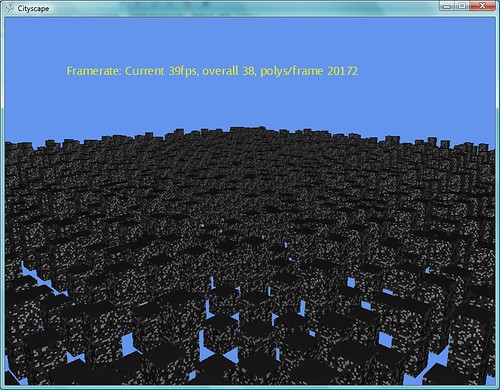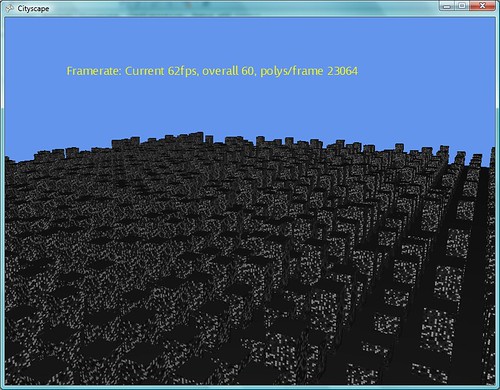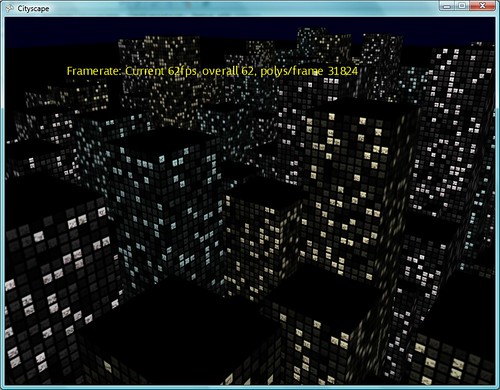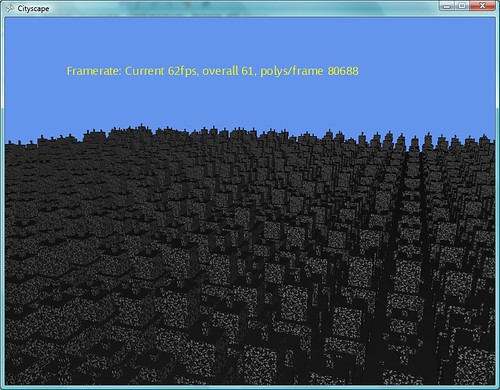Things have come on a bit since yesterday. I’ve added a first-pass of the building textures, and a polygon count (for reasons which will become apparent soon enough. Now, it looks like this:

The texture generation is simple enough (and mainly ripped off, like the rest of this project, from TwentySided’s PixelCity) – a 512×512 near-black texture, with 8×8 blocks of either light or dark grey scattered across it. To get the solid-black of the tops of the buildings, I’ve simply set the texture map to a single pixel at the bottom left of the texture.
Also, you’ll notice that I’ve added more buildings – in that screenshot, it’s a 31×31 grid of buildings (with random heights, for a bit of interest), and added a polygon count. Now, the reason I added the polygon count is interesting, and we’re going to learn a bit about how graphics cards work in the process.
So, I increased the number of buildings to 961, and the framerate stayed nice and happily at about 60fps. Excellent. Then, I got greedy, and made the grid 41×41, giving me 1681 buildings – and the framerate plumetted to around 40fps. This seemed odd – I’m not yet hitting really big polygon budgets. Games these days happily push hundreds of thousands, if not millions, of polygons per frame, and whilst XNA is doubtless adding some overhead, this machine manages to pull off things like Demigod and Dawn of War 2 on respectable settings without too much pain. So something, clearly, is up. I added a polygon counter just to check my sanity, and yes, we’ve nearly doubled our polygon budget, but it’s still only about 20k polys:

Hm. So, what do we do in this kind of situation? Well, we investigate! We’ve basically doubled our poly budget by doubling the number of buildings, right? Well, more or less, anyway. How about instead, we drop our number of buildings back to the original number, and increase their complexity? What happens then? So, I added the base back on, which is essentially just another box at the base of every building, and…

Wait, what? We’ve now got more polygons than we had in our 41×41 scenario and we’re still at ~60fps. Something odd is happening here. So what happens if we add more (mini-tower on top) and more (two stage body for the building) complexity? We can do three times as many polys as our original 31×31 city without a framerate drop – it’s only once we get to four times as many – fourty-six thousand, over twice as many polygons as in our 41×41 city – that we start to see any impact at all, and it’s only a couple of fps. What the merry hell is going on here, then?
Well, remember how our buildings are constructed: for each box, we insert the vertices and indices into an array, then convert these to fixed-size vertex buffers for use when rendering. There’s one of these buffers per building. As we’re adding more complexity to our buildings, we’re increasing the amount of stuff in each buffer; however, when we add more buildings, we’re increasing the number of these buffers that need rendering – so it seems that it’s the number of buffers (or, more accurately, the number of draw calls we make) that’s our killer here.
And this is an important point: think of a graphics card as being like a car engine. You get most efficiency out of an engine when you drive smoothly, and a moderately high (but not excessive) speed, without changing speed too much; driving around a city where you’re constantly braking, changing gear, stopping, starting and so forth is absolute murder on your engine’s efficiency – and it’s the same thing for graphics cards. Hand them a big buffer of triangles to go off and render, and they’ll tear through it at high efficiency. Hand them a whole load of small buffers, or change texture or shader regularly, and they really start to struggle.
The reason for this, more-or-less, is that the time for a render call is split into two parts – a fixed setup cost, and a variable rendering cost. If you’re rendering a large number of small batches, your render time is going to be dominated by a very large number of fixed setup costs; however, if you render a single large batch, you only have to do this setup once, and then the rest of the time can be spent on actually drawing the triangles.
So, what can we do about this? Well, that’ll have to wait until next time – but remember, all of our buildings are using the same texture, shader, vertex format, etc – so an obvious solutino should hopefully present itself!
(We’re up to bzr revision 13 now, if you’re following along at home)









